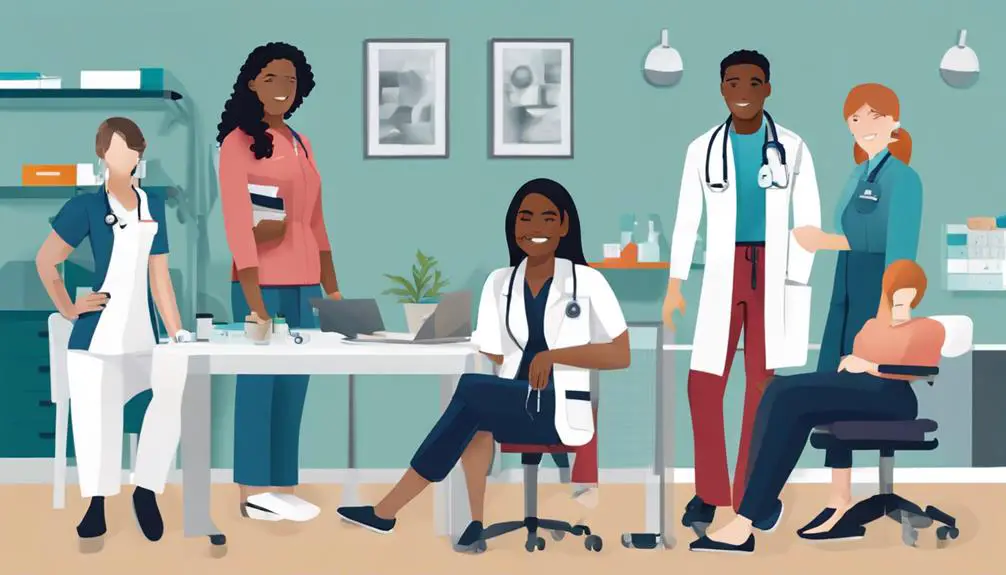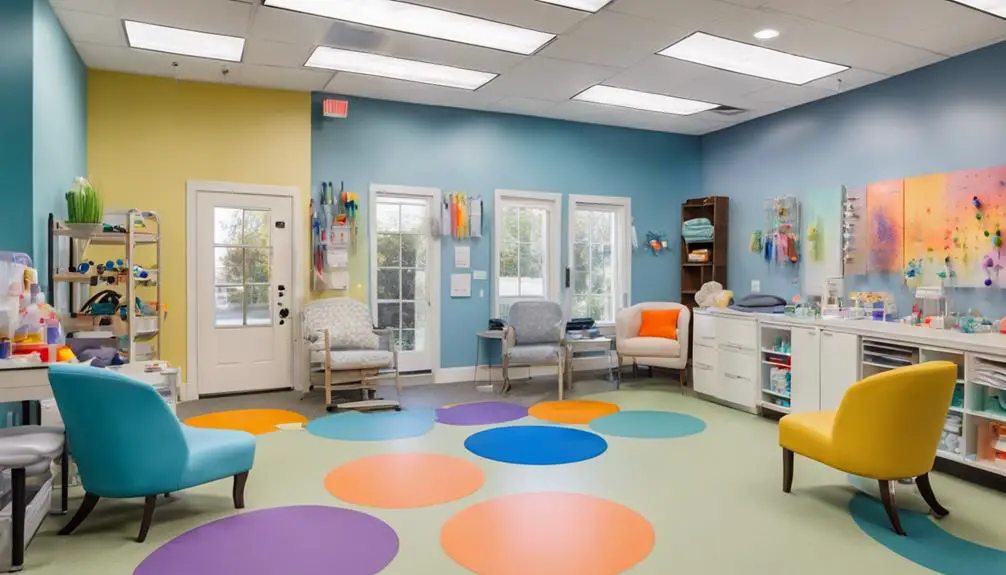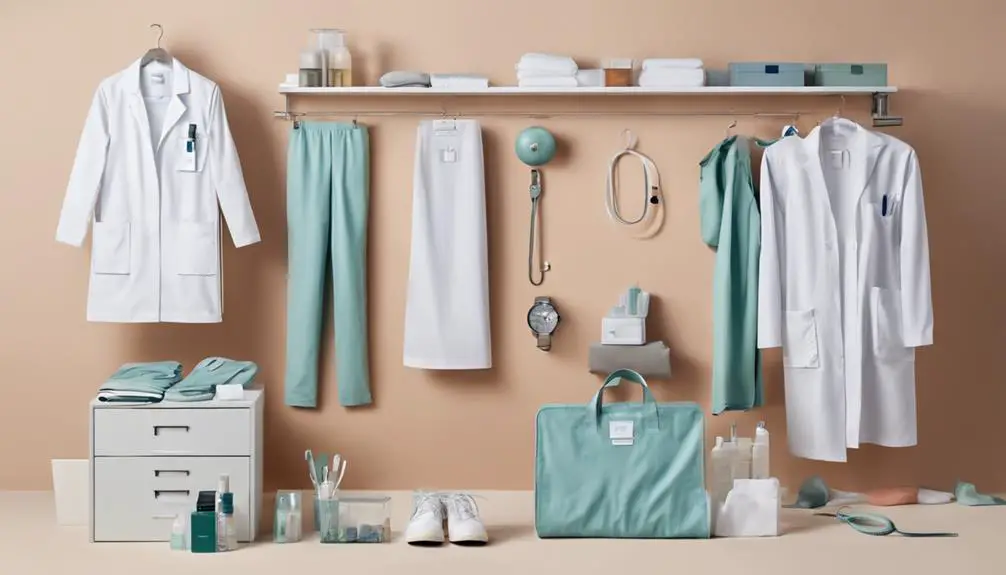To dress as an occupational therapist, you'll want to combine professionalism with comfort and practicality. Business casual attire is your best bet; think tailored pants or chinos and a breathable top. Always check your school's dress code for specific guidelines, as some may allow scrubs, while others prefer a more polished look. On your first day, opt for slightly dressier clothing to make a strong impression. Minimal jewelry and secured hair keep things safe and professional. Embrace versatility in your wardrobe to adapt to various activities, ensuring you're always ready for engaging interactions. Discover more tips to elevate your style!
Understanding Dress Codes

When it comes to understanding dress codes, you'll find that they can vary widely between school districts. This means it's essential for you to consult your staff handbook or reach out to school representatives for specific attire requirements. Each district sets its own standards, particularly for occupational therapists (OTs), and knowing these can help you make a great impression. It's also important to take into account how proper clothing care can preserve the quality of your attire, ensuring you always look professional and polished. As an OT, you'll generally find that business casual to casual attire is the norm. However, your clothing should be durable and flexible to allow for movement during therapy sessions. While some districts have started accepting scrubs, many OTs prefer to dress similarly to teachers. This choice helps maintain an educational focus rather than a medical appearance, which can foster a more comfortable environment for students.
On your first day, aim to dress slightly more formally than usual. This not only creates a professional impression but also helps you gauge the district's overall vibe. Keep in mind that safety and comfort should guide your clothing choices. Opt for minimal jewelry and secure hair to prevent any disruptions during your interactions with students.
Choosing First Day Attire
Starting your first day as an occupational therapist sets the tone for your time in the district, so it's important to choose your attire wisely. First-day attire can greatly impact how colleagues and students perceive you, making it essential to prioritize professionalism over comfort. Dressing slightly more formally than required helps create a strong first impression and allows you to gauge the district's overall vibe.
Here are some tips to reflect upon when selecting your first-day outfit:
- Dress Professionally: Aim for a polished look that reflects your role. This can mean tailored pants or a smart dress, paired with sensible shoes that allow for movement throughout your day.
- Observe Your Surroundings: Pay attention to the attire of other staff members. This observation can provide valuable insights into what's considered appropriate and help you plan for future days.
- Prioritize Flexibility: Choose durable and flexible clothing that allows you to engage in activities with students. Comfort is important, but it shouldn't come at the cost of professionalism.
- Establish Credibility: Your attire plays a significant role in establishing your credibility within the educational environment. Choosing appropriate outfits conveys that you take your role seriously and are ready to connect with students.
Typical Attire for OTs

Occupational therapists often find themselves in settings that require a blend of professionalism and practicality, so dressing appropriately is key. When you're working in occupational therapy, your attire should reflect the dynamic nature of your role while guaranteeing comfort and safety. Most OTs opt for business casual to casual clothing that's both durable and flexible, allowing for easy movement throughout the day.
For those working with preK-aged children, it's crucial to wear clothes that prioritize freedom of movement, while OTs in high school environments might choose slightly dressier outfits based on district norms. Notably, scrubs aren't typically favored in school settings; instead, dressing similarly to teachers helps maintain an educational focus.
Here's a quick overview of typical attire considerations for OTs:
| Clothing Type | Recommended Wear | Considerations |
|---|---|---|
| Tops | Long sleeves or polo shirts | Protects against aggressive behavior |
| Bottoms | Comfortable pants or chinos | Flexibility for movement |
| Accessories | Minimal jewelry | Guarantees safety in activities |
When you start your journey, observe what your colleagues wear on the first day. This can give you invaluable insights into the district's overall dress code vibe. Always remember, your attire in occupational therapy should strike a balance between being professional and practical, allowing you to focus on your important work with clients while feeling confident in your appearance.
Scrubs vs. Professional Wear
When it comes to choosing between scrubs and professional wear as an occupational therapist, you've got some important factors to take into account. While scrubs might offer comfort and ease of movement, they can sometimes feel a bit too clinical in a school setting, where you want to connect with students as a relatable figure. Opting for business casual attire not only reflects professionalism but also allows you to adapt to the dynamic environment of therapy sessions, making it a great choice for fostering those essential connections.
Scrubs: Pros and Cons
Choosing the right attire as an occupational therapist can greatly impact your interaction with students and staff. When considering scrubs versus professional wear, it's vital to weigh the pros and cons of each option. Scrubs have gained popularity, especially post-pandemic, but they come with unique considerations. Here are some key points to think about:
- Comfort and Mobility: Scrubs are designed for ease of movement, making them ideal for hands-on therapy sessions.
- Infection Control: They offer a practical option for hygiene, particularly in school settings where cleanliness is significant.
- Professional Appearance: While scrubs are accepted, they may seem too clinical in an educational environment, where a more polished look is often desired.
- Versatility: Unlike professional wear, scrubs may lack the flexibility to adapt to different school activities or settings.
Ultimately, the choice between scrubs and professional attire depends on your district's dress code, the age of your students, and your specific role within the school. By carefully considering these factors, you can select the attire that best supports your therapy practice while enhancing your professional image.
Business Casual Options
What's the best way to balance professionalism and approachability in your wardrobe as an occupational therapist? Opting for business casual attire is key. Unlike scrubs, which can feel too clinical, especially in school settings, tailored trousers and blouses present a polished yet friendly appearance. This choice not only aligns more with the educational focus of your role but also fosters a welcoming environment for students and their families.
Consider the age group you're working with; if you're helping younger children, you might want to wear clothing that allows for easy movement. This enhances your ability to engage with them actively while maintaining a professional look. On your first day, dressing slightly more formally can help you gauge the district's vibe, helping you adjust your future outfit choices while still staying within the business casual standard.
Although scrubs gained popularity during the pandemic, many occupational therapists continue to prefer flexible clothing that supports their active responsibilities. By choosing the right business casual options, you can confidently embrace your role, making a lasting impression while promoting a positive atmosphere in the world of occupational therapy.
Dress Code Considerations
Occupational therapists often face a choice between wearing scrubs or opting for professional attire, especially in school settings. While scrubs have gained some acceptance during the pandemic for infection control, they typically convey a more medical vibe, which might not fit the educational environment. Instead, many OTs prefer business casual or casual clothing that allows for greater mobility and aligns better with their role.
Here are some dress code considerations to keep in mind:
- First Impressions Matter: On the first day, consider slightly more formal attire to make a professional impression and gauge your school's vibe.
- Durability and Flexibility: Choose clothing that can withstand a variety of activities, especially when working with younger students who require more physical engagement.
- Observe and Adapt: Take note of your colleagues' attire on your first day—this can provide valuable insights into what's acceptable within your district.
- Comfort is Key: Select outfits that not only look good but also allow you to move freely throughout the day.
Essential Outfit Considerations

When you're dressing as an occupational therapist, striking the right balance between professionalism and comfort is key. You'll want to choose outfits that allow for movement while still looking polished, keeping in mind the diverse settings you might encounter throughout the day. Paying attention to dress codes and prioritizing flexibility will not only enhance your professional appearance but also boost your confidence as you engage with clients in meaningful ways.
Professional Appearance Matters
Your professional appearance plays an essential role in establishing credibility and trust as an occupational therapist. The way you dress can influence how clients, colleagues, and students perceive you, reflecting the rich history of the occupational therapy profession. Here are some essential outfit considerations to keep in mind:
- Dress Slightly More Formally: On your first day, dressing a bit more formally can help you gauge the district's vibe and create a positive impression.
- Choose Durable Clothing: Opt for flexible, durable clothing that accommodates movement, especially when working with younger clients or during active therapy sessions.
- Limit Jewelry: Use minimal jewelry for safety reasons; this reduces the risk of injury during interactions with patients.
- Secure Your Hair: Keep your hair secured to prevent students from pulling it, maintaining professionalism and safety in the therapy setting.
Comfort and Flexibility
In the fast-paced world of therapy, comfort and flexibility in your clothing can make all the difference. As an occupational therapist, you engage in activities that require movement—think bending, squatting, and lifting during therapy sessions. To guarantee you stay comfortable during those long hours, opt for breathable fabrics, especially in warmer climates.
Here's a quick overview of essential outfit considerations:
| Comfort | Flexibility |
|---|---|
| Choose breathable, lightweight fabrics | Select clothing that allows movement |
| Wear durable materials | Look for items with stretch |
| Opt for easy-care fabrics | Avoid restrictive fits |
| Keep jewelry minimal to prevent hazards | Prioritize layered outfits for adaptability |
When you prioritize comfort and flexibility in your attire, you enhance your ability to actively participate in various therapeutic activities without feeling restricted. Remember, your clothing should be durable and easy to maintain, as you might encounter various materials and environments that could soil or damage your outfits. By choosing the right attire, you not only look professional but also feel confident and ready to make a meaningful impact on your clients' lives.
Dress Code Awareness
Familiarizing yourself with the dress code outlined in your staff handbook is essential for any occupational therapist. Understanding the nuances of dress code awareness not only reflects the history of occupational therapy, but it also enhances professional interactions. Here are some key considerations to keep in mind:
- Formality on the First Day: Dress slightly more formally to gauge the district's overall vibe and make a strong first impression.
- Durability and Flexibility: Your clothing should be durable and flexible, allowing you to engage in various activities and interactions with students throughout the day.
- Minimal Jewelry and Secured Hair: For safety reasons, especially in environments with potentially aggressive behaviors, keep jewelry minimal and hair secured.
- Grooming Standards: Maintain cleanliness and have your hair styled appropriately to foster professionalism in therapy settings.
Building a Versatile Wardrobe
Occupational therapists need a versatile wardrobe that balances professionalism with comfort. You'll want to curate a mix of business casual and casual attire that allows for flexibility and movement during therapy sessions. Fundamental items like classic trousers and peplum shirts made from breathable fabrics guarantee you look polished while feeling at ease throughout the workday. Additionally, incorporating tailored vintage pieces, such as a vintage blazer can add a unique touch to your professional look while maintaining comfort.
Layering options, such as cardigans or light jackets, are essential for adapting to varying temperatures in different school environments. This way, you can be prepared for anything from a chilly classroom to a warm therapy room. Accessories also play a significant role; practical yet stylish handbags can enhance your overall outfit coordination without distracting from your client interactions.
When considering what to wear to work, remember to regularly update your seasonal collection. Lightweight fabrics for spring can keep you cool, while warm, elegant pieces for winter guarantee you remain cozy and professional. The goal is to create a wardrobe that reflects the nature of occupational therapy on social interactions, fostering an atmosphere of trust and approachability. By investing in versatile pieces, you not only enhance your professional image but also maintain your comfort, allowing you to focus on what really matters—helping your clients thrive. So, as you build your wardrobe, keep in mind the importance of versatility, style, and functionality to create a look that's both engaging and effective in your role as an occupational therapist.
Frequently Asked Questions
What Does an Occupational Therapist Wear?
When considering what an occupational therapist wears, focus on professional attire that allows flexibility. You'll typically choose occupational clothing that suits the environment, ensuring comfort while maintaining a polished and approachable appearance for your clients.
Do OTS Wear White Coats?
Did you know 70% of occupational therapists prefer casual attire? You won't see many OTs in white coats; instead, they choose occupational therapy attire that reflects their professional appearance, fostering a friendlier, more approachable environment.
What Do You Wear to Occupational Therapy Fieldwork?
For fieldwork attire, you'll want to wear clean, wrinkle-free clothing that represents professional dress. Consider a short lab coat and your OTA Program name pin, plus closed-toe, flat-soled shoes for safety and comfort.
What Does a Day as an Occupational Therapist Look Like?
A day as an occupational therapist's filled with meaningful patient interactions, inspiring therapy techniques, and collaborative assessments. You'll adapt to each moment, fostering growth and independence while ensuring every client's needs are met with compassion and expertise.



